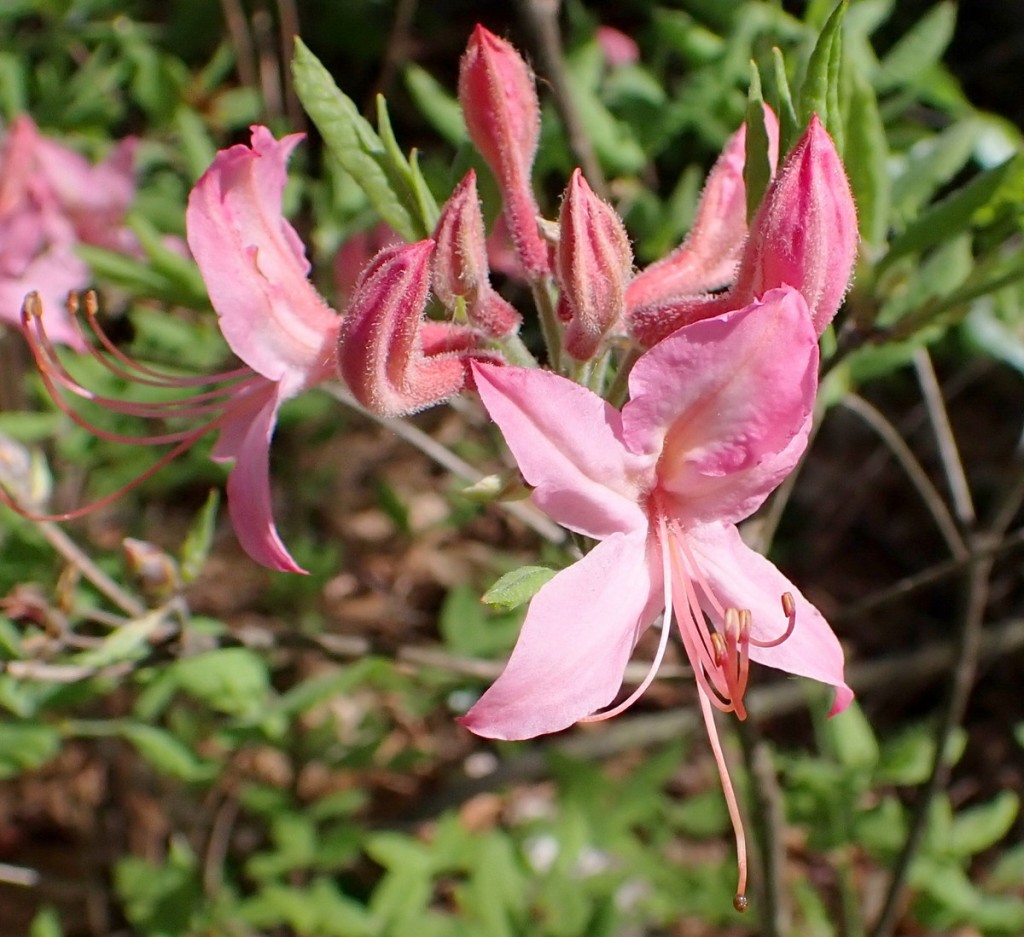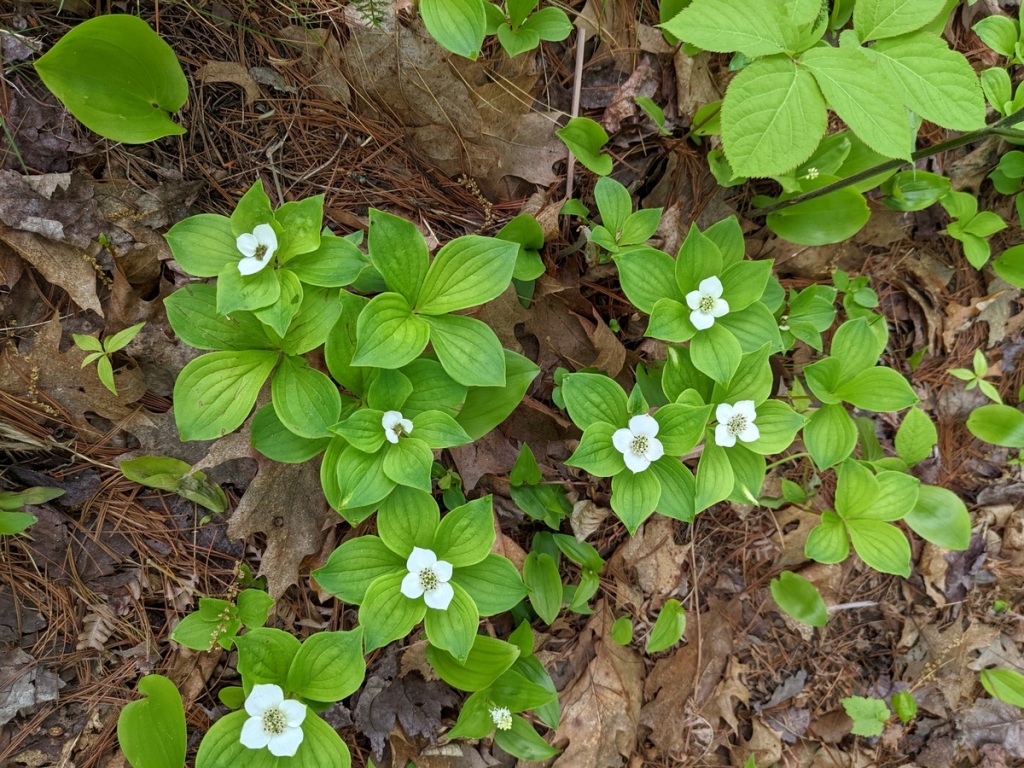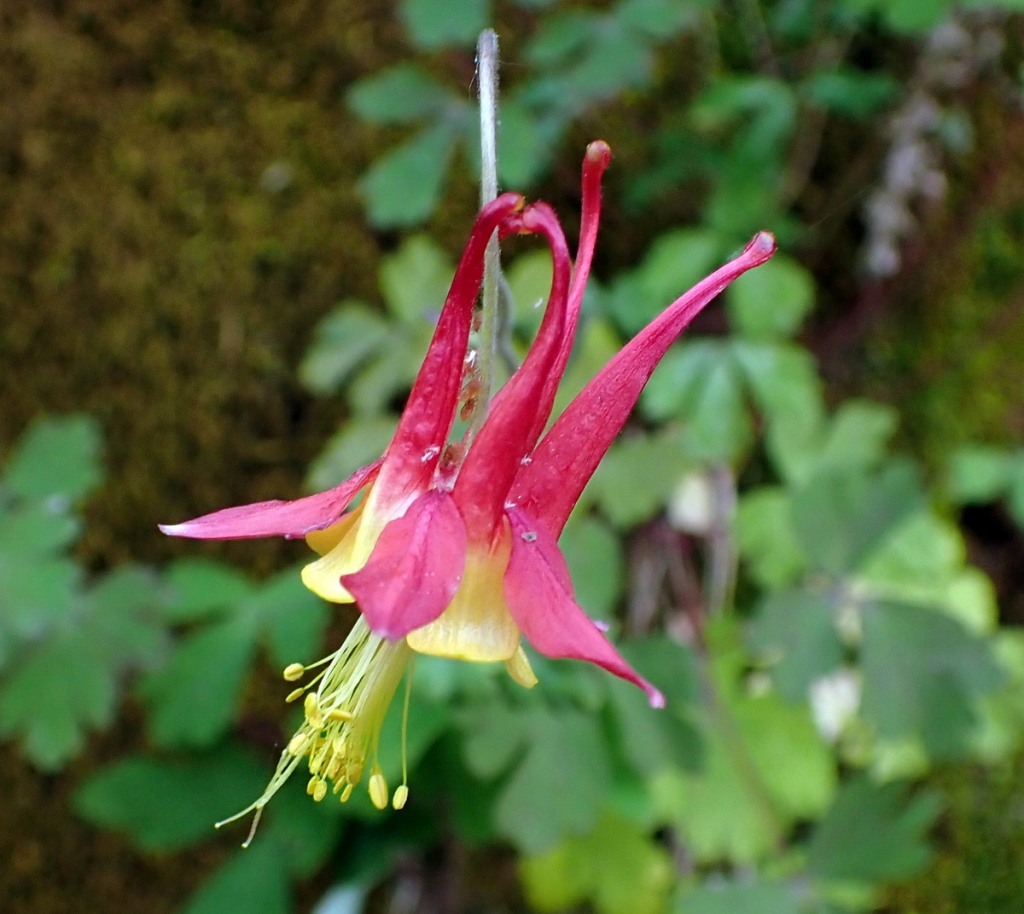
Here we are at the time of year when it’s almost time to leave the forest to seek the flowers that need sunlight rather than shade but first there are a few flowers still blooming in the woods, like the beautiful wild azalea (Rhododendron prinophyllum) seen in the photo above. They are also called early azaleas, though others in the family such as rhodora do bloom first. In my last post I spoke about finding the kind of beauty that makes me go silent and still, and this beautiful native shrub always does that to me.

This shot shows how hairy the buds are. Those hairs persist even after the flowers open and they are what give this plant another name: wooly azalea. It is those hairs that emit the wonderful fragrance that these flowers have. It is a fragrance that is said to induce creative imagination.

I’ve been waiting a few years now for pretty little bunchberry plants (Cornus canadensis) to have a good year and finally, here it is. If they look familiar that’s because they are in the dogwood family. Like a dogwood blossom its large white bracts surround its smaller flowers. Even the 2 larger and 4 smaller leaves look like a dogwood. In fact, an old name for the plant is creeping dogwood. They like moist, shady woods.

If pollinated each tiny flower will become a bright red, single seeded drupe, and the plant will then have the bunch of “berries” that give it its common name. It is rare in my experience to find a plant full of fruit, but I keep looking. The plant’s berries are loaded with pectin and Native Americans used them both medicinally and as food.

Here bunchberry plants are growing through the V made by two oak branches, as they do here almost every year. Bunchberry is often found growing on and through tree trunks, stumps, and fallen logs but exactly why isn’t fully understood. It’s thought that they must get nutrients from the decaying wood, and because of its association with wood it’s a very difficult plant to establish in a garden. Native plants that are dug up will soon die off unless the natural growing conditions can be accurately reproduced, so it’s best to just admire it and let it be.

I found a dogwood tree blooming at the local college so I took a photo of one of the flowers. It looks remarkably like a larger version of a bunchberry blossom, so it’s easy to see why they are in the same family.

Pretty little blue eyed grass blossoms (Sisyrinchium angustifolium), hardly bigger than an aspirin, have appeared. The plants are in the iris family and if I had gotten a better shot of the leaves it would be obvious. They are the same bluish gray color as those of bearded irises. It is just a roadside “weed” to many, but I look forward to seeing it each year.

Blue eyed grass flowers taught me this year that they come out very dark, like the blossom on the left and then fade rather quickly to look like that blossom on the left. I’ve never noticed this before.

What look like tiny purple airplanes are now carpeting forest floors. Though this little plant in the milkwort family’s common name is fringed polygala (Polygala paucifolia) another name is “gaywings,” so that tells me that I’m not the only one who sees the resemblance to planes. They’re small and at a glance can pass for a violet so you have to keep your eyes on the ground to find them.

They’re very pretty and worth finding. the flowers are made up of five sepals and two petals. Two of the petals form a tube and two of the sepals form the “wings.” The little fringe like structure at the end of the tube is part of the third petal which is mostly hidden. When an insect lands on the fringed part, the third petal drops down to create an opening so the insect can enter the tube. It’s an amazing process that I keep hoping I’ll see happen but so far, not yet.

As I always do, I immediately thought of my mother when I saw these white lilacs. She planted one just before she died and though I never knew her she lives on in the flowers she chose to plant in the yard. I know, by what she chose, that she loved both color and fragrance. When I sat on the porch as a boy and smelled the lilacs or the cabbage roses, or in the fall when I admired the beautiful scarlet leaves of the Virginia creeper she planted, she was there. And she still is. One of the greatest gifts you can give a child in my opinion, is a love of flowers. It doesn’t take much; my mother did it without even being there. Whatever flowers you grow they will learn to love them, and later on in life when they see a flower they grew up with, they’ll think of you.

Sweet woodruff (Galium odoratum) is a low growing summer wildflower with small, 4 petaled white flowers that seems to prefer the shade at the edges of forests. It makes an excellent old-fashioned groundcover but it likes plenty of water; it won’t spread if it gets too dry. The odoratum part of the scientific name comes from the pleasant, very strong fragrance of its dried leaves. They are often used in potpourris because the fragrance lasts for years. It is also called sweet scented bedstraw and is a native of Europe.

The long wiry stems of what I believe is marsh stitchwort (Stellaria palustris) keep the flowers up above the tall grass so insects can find them. The flowers are said to be smaller than those of greater stitchwort but larger than those of lesser stitchwort, but such things don’t excite me anymore so I don’t pay much attention. I just enjoy seeing their cheery faces alongside the path I’m on, even if they aren’t native. They are a native of Europe and are also called chickweed, but there are over 50 different chickweeds. The Stellaria part of the scientific name means “star like,” and the common name stitchwort refers to the plant being used in herbal remedies to cure the pain in the side that we call a stitch.

Lily of the valley (Convallaria majalis) had just started blooming when I found a large colony of them on one of my walks. This is one of the first plants I have stored in my memory. I can remember as a boy picking them along with violets and dandelions to bring to my grandmother. To this day I still like the colors white, yellow and purple together.

I found a painted trillium (Trillium undulatum) that had just come up. It hadn’t reached full size yet but it had the beginnings of the reddish “V” at the base of each petal. Someone thought it looked as if they had been painted on, and that’s where the common name comes from. This one also displayed where the undulatum part of the scientific name came from with its wavy, undulating petal edges. They will straighten out a bit as the plant grows. They like boggy, acidic soil and are much harder to find than other varieties, though I never did find nodding trilliums this year.

I had never seen bird’s eye speedwell (Veronica chamaedrys) anywhere but in Hancock where I used to work until I went grocery shopping and looked in an old pasture where a barn used to stand before the store was built. There were hundreds of them growing there, so if my memory still works in the future I’ll be able to see them whenever I want. Most speedwell flowers are borderline microscopic but these are huge in comparison. I’d guess they must be as big as an aspirin. Another name for the plant is germander speedwell.

Robin’s plantain (Erigeron pulchellus) is a flower that always makes me smile, and not just because it is so pretty. No, I smile because it is a flower that reveals a lot about people at this time of year. You can go by a house that has not a flower or flowering shrub or tree anywhere on its property, but then in spring a big island of robin’s plantain will have been left uncut in the mowed lawn. This plant is in the fleabane family and is the earliest fleabane to bloom, with big 1-inch blossoms. They can be white to pink to lavender and are made up of ray florets surrounding yellow disk florets in the center. It’s a pretty, very noticeable “weed.”

I went to a spot I had never been to off in the woods near Willard Pond in Hancock and found hundreds of pink lady’s slippers (Cypripedium acaule), more than I’ve ever seen together anywhere else. They’re one of our most beautiful native orchids and I was happy to see so many growing together. I wondered how many other large colonies there were off in the wilderness that nobody has ever seen. I hope there are many.

That flower in the previous photo was quite dark pink but here was one that was lighter. Lady’s slippers, as do all orchids, have both male and female reproductive structures fused into a single structure. Many different insects pollinate orchids but in lady’s slippers bees do the job. They enter the flower through the center slit in the pouch, which can be seen here. Once inside they discover that they’re trapped and can’t get out the way they came in.

Guide hairs inside the flower, which can just be seen in this shot, point the way to the top of the pouch or slipper, and once the bee reaches the top it finds two holes big enough to fit through. Just above each hole the flower has positioned a pollen packet so once the bee crawls through the hole it is dusted with pollen. The flower’s stigma is also located above the exit holes and if the bee carries pollen from another lady’s slipper it will be deposited on the sticky stigma as it escapes the pouch, and fertilization will have been successful. Is it any wonder that orchids are considered the most highly evolved of all flowering plants?

Pollination had been very successful in this spot. I saw many lady’s slipper seedpods. These seed pods contain between 10,000 and 20,00 tiny, dust like seeds. According to the U.S. Forest Service “The seeds require threads of a fungus in the Rhizoctonia genus to break them open and attach them to it. The fungus will pass on food and nutrients to the pink lady’s slipper seed. When the lady’s slipper plant is older and producing most of its own nutrients, the fungus will extract nutrients from the orchid roots. This mutually beneficial relationship between the orchid and the fungus is known as “symbiosis” and is typical of almost all orchid species.” This is why it is waste of time to collect orchids or orchid seed from the wild and expect them to grow in your yard.

Since I skipped doing a flower post one week, I’m behind in keeping up with showing you what is blooming and has bloomed here. I went back out to the ledges in Westmoreland as I said I would though, and found the columbines in beautiful, full bloom. This would have been about 2 weeks ago, I think. I was happy to find more plants blooming than I ever have before, and I hope some of you were also able to see them.

There is no other flower that I know of that is quite like them. When a breeze blows through where they grow, they all dance at the ends of their long wiry stems and you can imagine them making themselves more visible to the insect by doing so.

I always like to show this photo of a columbine blossom from a few years ago because it helps to illustrate how various names came to be attached to this flower. The Aquilegia part of the scientific name comes from the Latin Aquila, which means “eagle” and refers to the spurred petals that Swedish botanist Carl Linnaeus thought resembled an eagle’s talons. Others have thought they resembled pigeons around a dish, and the name Columbine comes from the Latin Columbinus, which means “pertaining to doves or pigeons.” Throughout history columbines have been associated with birds, but I didn’t see eagles or doves when I saw this photo. I immediately thought of five beautiful white swans with outstretched wings. However you choose to look at a columbine blossom it is a beautiful thing, and growing them adds interest to any garden.
Let the beauty we love be what we do.
There are hundreds of ways to kneel and kiss the ground.
~Rumi
Thanks for coming by.